AI advisory committee wants law enforcement agencies to rethink use case inventory exclusions

There’s little debate that facial recognition and automated license plate readers are forms of artificial intelligence used by police. So the omissions of those technologies in the Department of Justice’s AI use case inventory late last year were a surprise to a group of law enforcement experts charged with advising the president and the National AI Initiative Office on such matters.
“It just seemed to us that the law enforcement inventories were quite thin,” Farhang Heydari, a Law Enforcement Subcommittee member on the National AI Advisory Committee, said in an interview with FedScoop.
Though the DOJ and other federal law enforcement agencies in recent weeks made additions to their use case inventories — most notably with the FBI’s disclosure of Amazon’s image and video analysis software Rekognition — the NAIAC Law Enforcement Subcommittee wanted to get to the bottom of the initial exclusions. With that in mind, subcommittee members last week voted unanimously in favor of edits to two recommendations governing excluded AI use cases in Federal CIO Council guidance.
The goal in delivering updated recommendations, committee members said, is to clarify the interpretations of those exemptions, ensuring more comprehensive inventories from federal law enforcement agencies.
“I think it’s important for all sorts of agencies whose work affects the rights and safety of the public,” said Heydari, a Vanderbilt University law professor who researches policing technologies and AI’s impact on the criminal justice system. “The use case inventories play a central role in the administration’s trustworthy AI practices — the foundation of trustworthy AI is being transparent about what you’re using and how you’re using it. And these inventories are supposed to guide that.”
Office of Management and Budget guidance issued last November called for additional information from agencies on safety- or rights-impacting uses — an addendum especially relevant to law enforcement agencies like the DOJ.
That guidance intersected neatly with the NAIAC subcommittee’s first AI use case recommendation, which permitted agencies to “exclude sensitive AI use cases,” defined by the Federal CIO Council as those “that cannot be released practically or consistent with applicable law and policy, including those concerning the protection of privacy and sensitive law-enforcement, national security, and other protected interests.”
Subcommittee members said during last week’s meeting that they’d like the CIO Council to go back to the drawing board and make a narrower recommendation, with more specificity around what it means for a use case to be sensitive. Every law enforcement use of AI “should begin with a strong presumption in favor of public disclosure,” the subcommittee said, with exceptions limited to information “that either would substantially undermine ongoing investigations or would put officers or members of the public at risk.”
“If a law enforcement agency wants to use this exception, they have to basically get clearance from the chief AI officer in their unit,” Jane Bambauer, NAIAC’s Law Enforcement Subcommittee chair and a University of Florida law professor, said in an interview with FedScoop. “And they have to document the reason that the technology is so sensitive that even its use at all would compromise something very important.”
It’s no surprise that law enforcement agencies use technologies like facial or gait recognition, Heydari added, making the initial omissions all the more puzzling.
“We don’t need to know all the details, if it were to jeopardize some kind of ongoing investigation or security measures,” Heydari said. “But it’s kind of hard to believe that just mentioning that fact, which, you know, most people would probably guess on their own, is really sensitive.”
While gray areas may still exist when agencies assess sensitive AI use cases, the second AI use case exclusion targeted by the Law Enforcement Subcommittee appears more cut-and-dried. The CIO Council’s exemption for agency usage of “AI embedded within common commercial products, such as word processors or map navigation systems” resulted in technologies such as automated license plate readers and voice spoofing to often be left on the cutting-room floor.
Bambauer said very basic AI uses, such as autocomplete or some Microsoft Edge features, shouldn’t be included in inventories because they aren’t rights-impacting technologies. But common commercial AI products might not have been listed because they’re not “bespoke or customized programs.”
“If you’re just going out into the open market and buying something that [appears to be exempt] because nothing is particularly new about it, we understand that logic,” Bambauer said. “But it’s not actually consistent with the goal of inventory, which is to document not just what’s available, but to document what is actually a use. So we recommended a limitation of the exceptions so that the end result is that inventory is more comprehensive.”
Added Heydari: “The focus should be on the use, impacting people’s rights and safety. And if it is, potentially, then we don’t care if it’s a common commercial product — you should be listing it on your inventory.”
A third recommendation from the subcommittee, which was unrelated to the CIO Council exclusions, calls on law enforcement agencies to adopt an AI use policy that would set limits on when the technology can be used and by whom, as well as who outside the agency could access related data. The recommendation also includes several oversight mechanisms governing an agency’s use of AI.
After the subcommittee agrees on its final edits, the three recommendations will be posted publicly and sent to the White House and the National AI Initiative Office for consideration. Recommendations from NAIAC — a collection of AI experts from the private sector, academia and nonprofits — have no direct authority, but Law Enforcement Subcommittee members are hopeful that their work goes a long way toward improving transparency with AI and policing.
“If you’re not transparent, you’re going to engender mistrust,” Heydari said. “And I don’t think anybody would argue that mistrust between law enforcement and communities hasn’t been a problem, right? And so this seems like a simple place to start building trust.”






